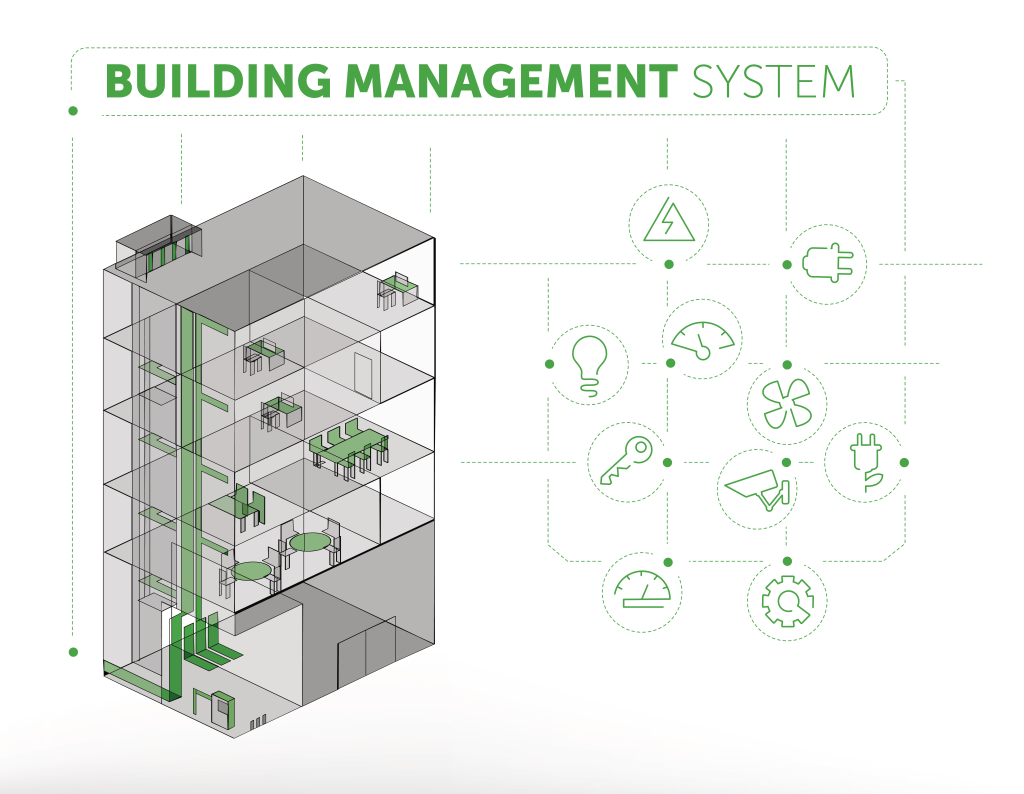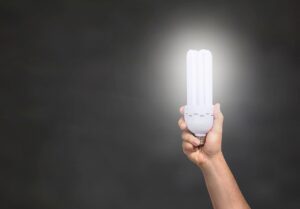The seamless integration of various subsystems within a commercial building is essential for optimizing performance, enhancing efficiency, and ensuring a comfortable environment for occupants. Among these subsystems, lighting controls play a crucial role. In this blog post, we will focus on the integration of Integrated Light Controls with Building Management Systems (BMS) and how this amalgamation can lead to smarter and more efficient buildings.
What is a Building Management System (BMS)?
A Building Management System (BMS), also known as a Building Automation System (BAS), is a centralized control system that monitors and manages the mechanical, electrical, and electromechanical services within a building. These services can include heating, ventilation, air-conditioning (HVAC), elevators, security systems, and of course, lighting.
The BMS acts as the “brain” of the building, collecting data from various sensors and devices throughout the facility. It then processes this data to make informed decisions and optimize the performance of the building’s subsystems. By integrating light controls with the BMS, building operators gain the ability to manage lighting alongside other critical systems from a single interface, fostering a holistic and intelligent approach to building management. This integration empowers building managers to create personalized and energy-efficient lighting schedules, respond to changing environmental conditions, and enhance overall occupant experience while contributing to the building’s sustainability goals.

The Significance of Light Controls
Lighting in commercial buildings not only impacts the comfort of occupants but also contributes significantly to energy consumption. Integrating lighting control systems with the BMS allows for coordinated control over the building’s lighting alongside other systems. This enables a more comprehensive and intelligent approach to building management.
An additional advantage of integrating light controls with Building Management Systems is the ability to streamline data analysis and facilitate informed decision-making. The BMS collects a wealth of data from various subsystems, including lighting. With this data, building managers can analyze patterns and trends, such as peak usage times, the effectiveness of daylight harvesting, and occupancy behaviors. This information can be invaluable for making decisions on how to further optimize the lighting controls in conjunction with other systems for greater efficiency and cost savings.
As a further development within Enhanced Energy Efficiency, integrating light controls with Building Management Systems allows for the implementation of predictive analytics in energy management. Predictive analytics involves using historical data and real-time information to predict future trends and patterns. In the context of lighting control, this can enable the system to make intelligent decisions about lighting usage based on predicted occupancy or natural light availability.
Enhanced Energy Efficiency
Leveraging Predictive Analytics for Proactive Energy Management
As a further development within Enhanced Energy Efficiency, integrating light controls with Building Management Systems allows for the implementation of predictive analytics in energy management. Predictive analytics involves using historical data and real-time information to predict future trends and patterns. In the context of lighting control, this can enable the system to make intelligent decisions about lighting usage based on predicted occupancy or natural light availability. For instance, if the system predicts a sunny day, it may decide to rely more on natural light, thus saving energy by reducing the usage of artificial lights.
Integration with Renewable Energy Sources
Another expansion within the realm of enhanced energy efficiency is the integration of light controls with renewable energy sources. For commercial buildings equipped with solar panels or other forms of renewable energy, the Building Management System can be programmed to utilize these sources optimally for lighting. During peak energy production periods, such as midday for solar power, the system can be configured to draw more power from these renewable sources, further reducing the reliance on grid electricity and lowering the carbon footprint of the building.
Load Shedding and Peak Demand Management
Commercial buildings often face higher electricity rates during peak demand periods. By integrating lighting controls with the Building Management System, strategies such as load shedding can be employed. Load shedding involves reducing the energy consumption during peak demand times. The BMS can be programmed to dim lights or turn off non-essential lights during these periods, thus reducing the demand and avoiding higher electricity rates.
Improved Occupant Comfort and Productivity
Creating a Human-Centric Lighting Environment
A primary aspect of improved occupant comfort and productivity through integrated lighting controls is the creation of human-centric lighting environments. Human-centric lighting focuses on the occupant’s well-being and is designed to enhance mood, performance, and health. By adjusting the color temperature and intensity of the lighting throughout the day to mimic natural light patterns, a human-centric lighting system can help regulate the circadian rhythms of occupants, leading to better sleep quality and increased alertness during waking hours.
Task-Specific Lighting
Different tasks and activities may require different lighting conditions. For instance, an employee working on detailed paperwork may need brighter and more focused lighting than someone engaged in a brainstorming session. Integrated lighting controls enable customization of lighting based on specific tasks, which not only improves occupant comfort but can also lead to increased productivity.
Reduced Eye Strain and Fatigue
Improper lighting is a common cause of eye strain and fatigue. By having intelligent light controls integrated with the Building Management System, the lighting can be automatically adjusted based on the natural light available and the specific needs of the space. This helps in reducing eye strain and fatigue among occupants, which in turn can improve concentration and productivity.
Simplified Building Operation and Maintenance
Streamlined Operation and Monitoring
Integrating light controls with Building Management Systems simplifies the operation and monitoring of the entire building. By having a centralized control system, facility managers can easily access and manage the lighting controls alongside other building systems from a single interface. This streamlines the overall operation and reduces the complexity of managing multiple subsystems separately.
Centralized Control and Automation
With integrated light controls, building operators can automate routine lighting tasks and schedules, eliminating the need for manual intervention. For example, the BMS can be programmed to automatically turn on/off or dim lights based on occupancy patterns, time of day, or daylight availability. This automation not only improves operational efficiency but also reduces the workload of facility staff.
Remote Access and Troubleshooting
Another advantage of integrating light controls with a BMS is the ability to access and control the lighting system remotely. This is particularly beneficial for large or multi-site commercial buildings. Facility managers can remotely monitor the lighting status, adjust settings, and troubleshoot issues without physically being present at each location. This remote accessibility saves time and resources while enabling quick response to any lighting-related concerns.
Efficient Maintenance and Diagnostics
Integrating light controls with the BMS simplifies maintenance tasks and enhances the diagnostic capabilities of the system. The BMS can provide real-time data and alerts related to the performance of the lighting system. It can monitor energy usage, lamp life, and detect faults or failures. With this information readily available, maintenance personnel can proactively address issues, plan maintenance schedules, and ensure the optimal functioning of the lighting system.
Cost Reduction
Energy Cost Savings
One of the primary benefits of integrating light controls with Building Management Systems is the potential for significant energy cost savings. By leveraging intelligent controls, lighting can be optimized to align with actual occupancy and daylight conditions, eliminating unnecessary energy usage. Occupancy sensors can ensure that lights are only active when needed, while daylight harvesting technology adjusts artificial lighting levels based on available natural light. These measures lead to reduced electricity consumption, resulting in lower energy bills for the building owner or tenant.
Maintenance and Replacement Cost Reduction
Integrated light controls can also contribute to cost reduction in terms of maintenance and replacement expenses. With the ability to monitor and manage the lighting system through the BMS, facility managers can proactively address maintenance issues, ensuring that lighting fixtures are functioning optimally. This proactive approach helps to prevent potential problems from escalating and reduces the need for costly emergency repairs. Additionally, by optimizing lighting usage, the lifespan of lighting fixtures is prolonged, reducing the frequency of replacements and the associated costs.
Demand Response and Peak Load Management
Another way integrated light controls can lead to cost reduction is through demand response and peak load management. During periods of high electricity demand, utility companies often impose higher rates. With integrated light controls, the Building Management System can be programmed to reduce lighting load during these peak demand periods through load shedding or dimming strategies. By managing lighting usage to avoid peak load conditions, building owners can minimize demand charges and achieve cost savings.
Improved Financial Planning and Budgeting
Integrating light controls with the BMS provides better visibility and data for financial planning and budgeting purposes. The BMS can track and record energy usage patterns, allowing facility managers to accurately forecast lighting-related expenses. This information helps in creating realistic budgets, identifying opportunities for further energy efficiency measures, and optimizing resource allocation.
Enhanced Sustainability Reputation
Beyond immediate cost savings, the integration of light controls with Building Management Systems contributes to a more sustainable building operation. By reducing energy consumption, buildings with efficient lighting controls lower their carbon footprint, which aligns with environmental goals and sustainability initiatives. This enhanced sustainability reputation can have positive implications for the building’s image and market value, potentially attracting environmentally-conscious tenants and stakeholders.
Security and Emergency Response
Enhanced Surveillance and Deterrence
By integrating light controls with security systems, lighting can be strategically utilized to enhance surveillance and deter potential threats. Motion sensors and intelligent lighting algorithms can automatically activate lights in specific areas when motion is detected, ensuring that surveillance cameras capture clear images and videos. Well-illuminated spaces act as a deterrent for criminals, reducing the likelihood of security breaches.
Adaptive Lighting for Security Zones
Light controls can be programmed to provide adaptive lighting for specific security zones within a building. For instance, access control points, parking areas, or sensitive areas can have customized lighting schedules and intensity levels. During non-operational hours or restricted access times, the lighting in these areas can be adjusted to ensure proper visibility while minimizing energy consumption. This targeted approach to lighting enhances security measures and reduces unnecessary illumination in low-traffic areas.
Emergency Lighting and Wayfinding
During emergencies such as fires or power outages, light controls are crucial for providing emergency lighting and facilitating safe evacuation. By integrating with emergency systems, lighting controls can automatically activate emergency lighting fixtures and guide occupants towards designated exit routes. Illuminated exit signs and pathways play a critical role in wayfinding, ensuring that occupants can navigate the building safely in stressful situations.
Centralized Activation of Security Lighting
Integration with a central Building Management System allows for centralized activation of security lighting when needed. Facility managers or security personnel can trigger pre-programmed lighting scenarios in response to specific security events or alarms. For instance, in the event of a security breach or unauthorized access, the BMS can activate all lights in the affected area to maximize visibility for security personnel and deter the intruder.
Final Thoughts
In conclusion, integrating light controls with Building Management Systems offers significant benefits for commercial buildings. It enhances energy efficiency, reduces costs, improves occupant comfort and productivity, simplifies operations and maintenance, and enhances security and emergency response capabilities. To unlock these advantages and transform your commercial building, reach out to Daisy Energy today at 877-352-0024 or visit our website. Let us help you create a brighter, greener, and more intelligent future for your space.




































